
Image from Canva
Welcome to Alaska!
With its rugged beauty and promise of adventure, Alaska frequently tops travelers' bucket lists and military PCS dream sheets.
And for good reason— Alaska is well known for its unique combination of gorgeous scenery and endless opportunities to explore! During the summer months, you'll find abundant wildlife. It’s not uncommon to see bears, moose, wolves, whales, sea lions, and eagles on a regular basis. The winter is packed with outdoor activities for those who love to play in the snow. With the gorgeous landscape, hunting and fishing unparalleled to other locations, and the northern lights regularly visible in the winter, nature is always on display in Alaska.

Image from Canva
Alaska has long been a strategic location for a military presence in the Arctic, dating back to 1867 when the US brokered a deal to purchase Alaska from Imperial Russia. As military missions became increasingly important during World War II, military units and airfields continued to expand across Alaska.
How many military bases are in Alaska?
Today, there are military installations across the state:
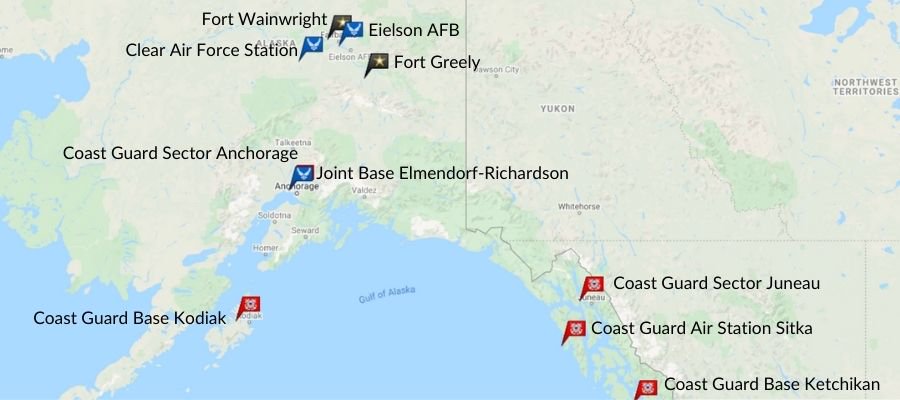
Military Bases in Alaska- Image from MilitaryByOwner
Clear Air Force Station is home to the 13th Space Warning Squadron whose primary mission is to provide early warning of intercontinental and submarine launched ballistic missiles to Missile Warning Center at North American Aerospace Defense Command. The secondary mission of the 13SWS is to provide space surveillance data on orbiting objects to the Space Control Center located at the Cheyenne Mountain Complex in CO. Clear AFS is located in Anderson, AK about 76 miles southwest of Fairbanks, AK.
U.S. Coast Guard Air Station Sitka’s area of responsibility encompasses the entire Southeast region of Alaska from Dixon Entrance north to Central Alaska and from the U.S./Canadian border west to the central Gulf of Alaska. Air Station Sitka operates in the most demanding flight environment for Coast Guard aircraft operations, with 12,000 miles of isolated and rugged coastline, to include inland search and rescue for Southeast Alaska, a region which includes numerous remote villages.
Coast Guard Base Ketchikan is a multi-mission unit providing support to much of southeast Alaska. Base Ketchikan's assets include a dry-dock, industrial production facility, comptroller and procurement shops, and an administrative suite to provide personnel support, making it a key player in providing support for all Coast Guard activities in the area.
Coast Guard Base Kodiak is on Kodiak Island and is the home of the Coast Guard's largest operational base. The base consists of 23,000 acres of land and supports both cutters and aircraft. Coast Guard Base Kodiak includes Air Station Kodiak, LORAN Station Kodiak, and other units in the CG's Seventeenth District (Alaska).
Coast Guard Sector Anchorage has the largest geographical area of responsibility in the nation, which includes the oil rich North Slope, Bering Sea, Chukchi Sea, Bristol Bay, Kodiak Island, Kenai Peninsula, and the Aleutian Islands. Sector Anchorage benefits from unique joint training opportunities available due to its being located near Joint Base Elmendorf-Richardson with Air Force, Army, and Alaska National Guard and Reserve units nearby.
Coast Guard Sector Juneau is a multi-mission unit based in Juneau, Alaska. The command consists of approximately 250 active duty, reserve, and civilian members with ten field commands and detachments. Sector Juneau's personnel provide a vital Coast Guard presence in four strategic Southeast Alaska communities, and conduct operations in over 20 remote areas and native villages on over 2,000 islands and 10,000 miles of shoreline.
Eielson Air Force Base is home to the Pacific Air Forces 354th Fighter Wing. Eielson AFB can rapidly deploy Airmen in support of global operations, and its strategic location also enables the staging of forces to promote U.S. interests in the Asia-Pacific region.
Fort Greely, located alongside the Alaskan city of Delta Junction, is approximately 100 miles southeast of Fairbanks, and is a United States Army launch site for anti-ballistic missiles. It is also the home of the Cold Regions Test Center as Fort Greely is one of the coldest areas in Alaska and can accommodate cold, extreme cold, or temperate weather tests depending on the season. Fort Greely is served by nearby Allen Army Airfield located about three miles south of Delta Junction.
Fort Wainwright is the home of America's Arctic Warriors and is one of the Army's largest training areas. Home to the Northern Warfare Training Center, the Army's only cold region training proponent, soldiers at Fort Wainwright work and train in temperatures ranging from 80 in the summer to minus 50 in the winter.
Joint Base Elmendorf-Richardson (JBER) is home of Headquarters, Alaskan Command, Alaskan NORAD Region, Eleventh Air Force, and the 3rd Wing. JBER is also home to Headquarters, U.S. Army Alaska, Alaska National Guard, and Headquarters, Coast Guard Sector Anchorage. JBER also hosts several non-military activities, including a U.S. National Cemetery and a state-owned fish hatchery.
A military assignment to Alaska is like none other! While it can be expensive to fly back to the “lower 48” while stationed here, it’s a great place for family and friends to visit you. Many military and their families absolutely love Alaska, with some returning to call "America's Last Frontier" their permanent home after retirement.
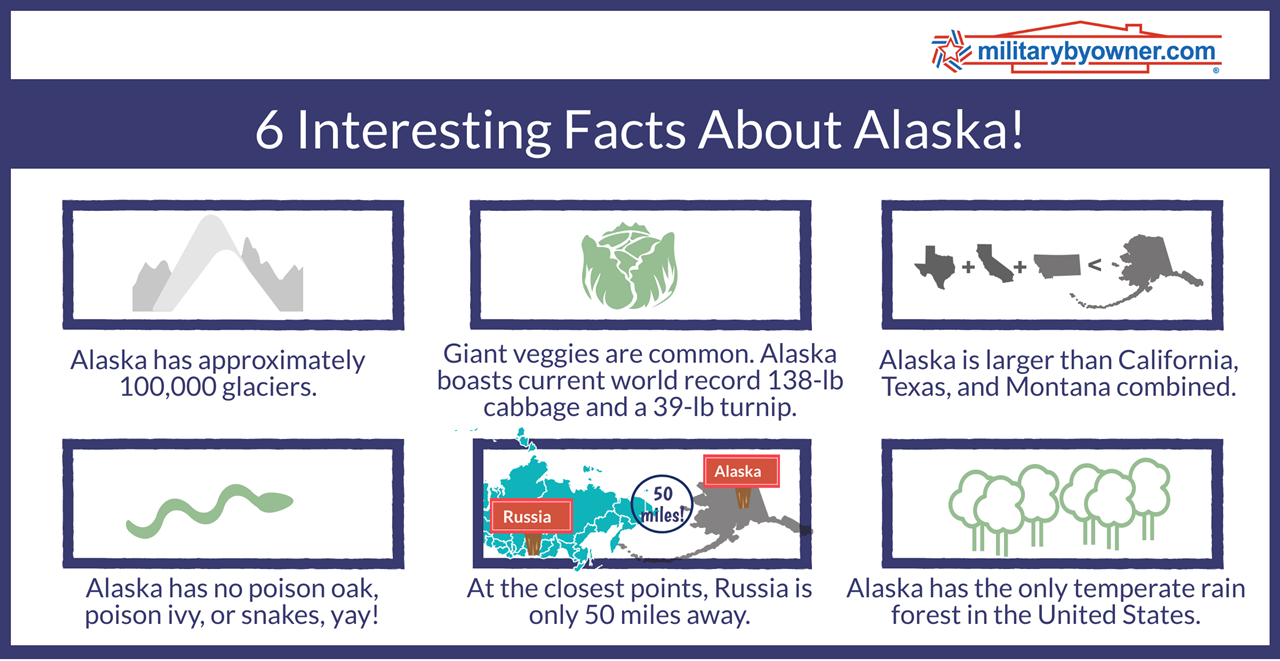
back to top
What should I know before my move to Alaska?
Getting to Alaska
There are three ways to get to Alaska: fly, drive, or ferry (ferry departs from Washington state), or a combination of the above. Key considerations for travel will be the time of year you’re moving and where you’re coming from. From the end of September through mid-April, it's best to fly, unless you’re experienced in driving in severe winter conditions.
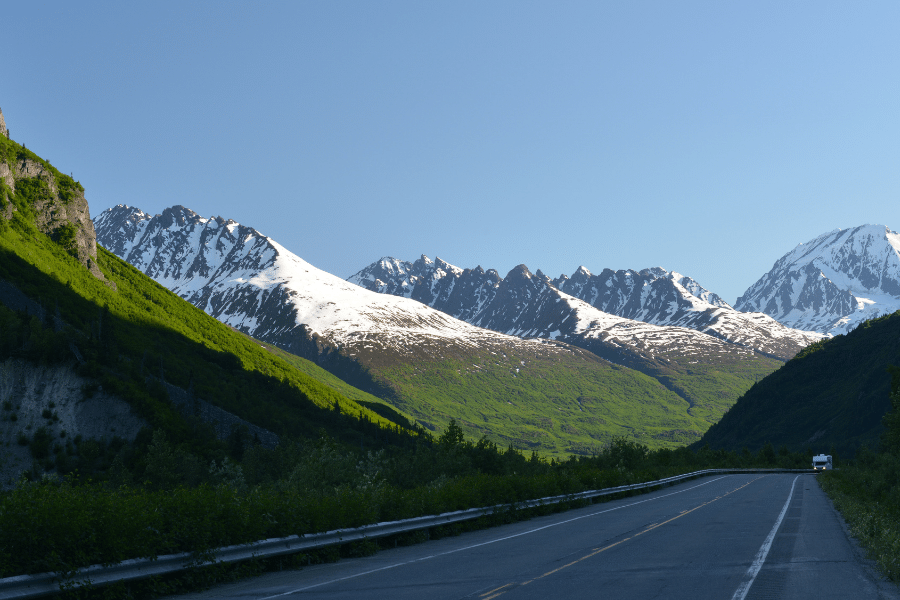
Richardson Highway Near Tolsona, Alaska. Image from Canva.
Winterizing Your Vehicle for Travel
If you’ll be driving to Alaska in winter or early spring, prepare the vehicle for winter travel before you depart. Have a mechanic check the battery, antifreeze, windshield fluid, wipers, and oil (oil change recommended before travel). You’ll want to replace certain fluids with winter-grade equivalents and install winter tires. Get tire chains, and have the mechanic teach you how to apply them.
Regardless of what months you are traveling, bring gear for changing weather. It can snow at higher elevations in the summer. Keeping a pair of gloves in your vehicle can be helpful, especially in the fall or spring when weather is unpredictable.
Learn more about driving in Alaska.
Alaska Weather
When you think of Alaska, often the first thing that comes to mind is snow! But depending on where you’re stationed, the weather can vary widely, especially with elevation changes.
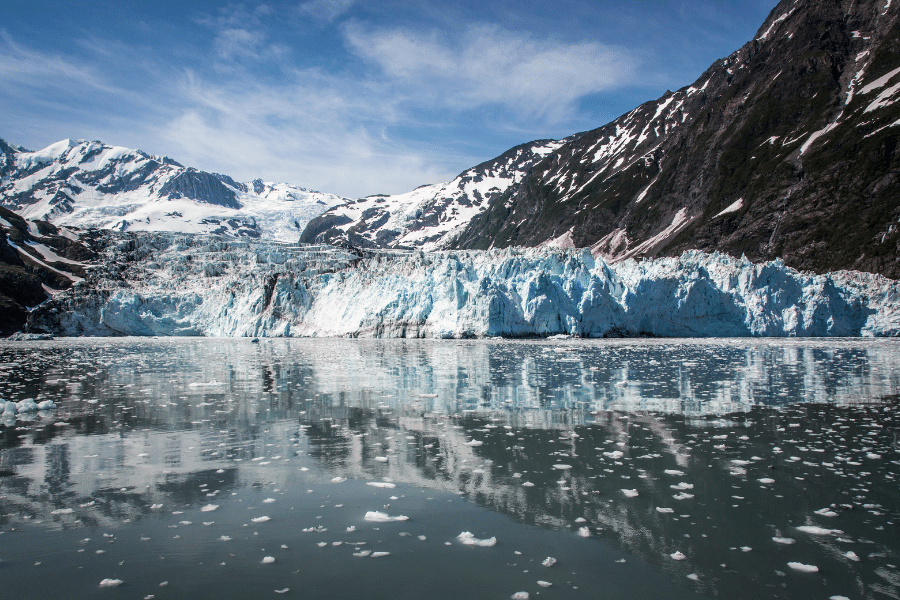
Image from Canva
For instance, Anchorage and Fairbanks are very different. Anchorage is a milder, coastal town, while Fairbanks lies on the Alaskan tundra. The Anchorage area has a more temperate climate than might be expected. The area gets quite a bit of snow (averaging 182 inches annually), but it’s not the squalling, constant blizzard you might be expecting. In the coldest months of January and February, the temperatures average 14 to 23 degrees.
In central Alaska, the weather fluctuates greatly. In the summer, days reach almost 90 degrees, countered drastically by -50 degree days in the winter. Heavy snowfall is expected October through January; however, it’s not uncommon to see snow into May. Suffice it to say, there’s no leaving part of your wardrobe behind, as you’ll need to be prepared for anything and everything!
You’ve probably heard it, but the “midnight sun” is real. It causes nearly 20-hour days of sunshine during the summer and only about four hours of daylight during the shortest days of winter. As you can imagine, these extreme changes can make for a difficult adjustment. Just as you’ll learn to embrace light-blocking shades to rest during those long summer months, invest in sunlight lamps to help keep your spirits up during the long winter months.
There are tons of outdoor activities in both Fairbanks and Anchorage, but mosquitoes in the summer can be a challenge. They’re nicknamed “the state bird!” (In fact, soldiers manning the drop zones for airborne operations are literally under netting and wear battery operated repellent systems.)
See more about preparing for winter weather in Alaska.
back to top
What should I bring to Alaska? What should I leave behind?
When shopping in Alaska, the guidance is if you see it—buy it! Inventory sells quickly, particularly for seasonal and popular items. Some items are worth bringing to Alaska; some are not.
Clothing You'll Need in Alaska
Alaska tends to have a higher cost of living, so if you currently live in a cold-weather climate, you’ll likely save money buying essential winter gear, such as coats, hats, gloves, snowsuits, and snow pants, before you come. If you’re coming from a warm-weather climate, acquiring winter clothing might not be an option; meaning you’ll need to consider ordering online or setting aside room in the budget to acquire items in Alaska.
At a minimum, bring a heavy, warm coat for each family member, fleece and rain jackets, and a good pair of water-resistant shoes. Many elect to buy heavy winter boots (and shoe spikes, aka “tire chains” that wrap over your existing shoes) in Alaska, as there’s usually a plethora of options and weather-ratings available.
- Big chains: REI, Cabela’s, Bass Pro Shop, Costco.
- Local stores: AMH (Alaska Mountaineering & Hiking), Big Rays, and Fred Meyer grocery stores.
In the Fairbanks area, your concern with winter gear is as much warmth as it is in being water repellent. The snow is drier in Fairbanks and the temperatures much colder than along the coast. One military spouse mentioned that she could literally sweep the snow rather than shovel! Although you can always go outside for activities like cross-country skiing and snowshoeing, Fairbanks can get so cold that you just can’t keep warm, no matter what you’re doing. It is near the town of North Pole, after all.
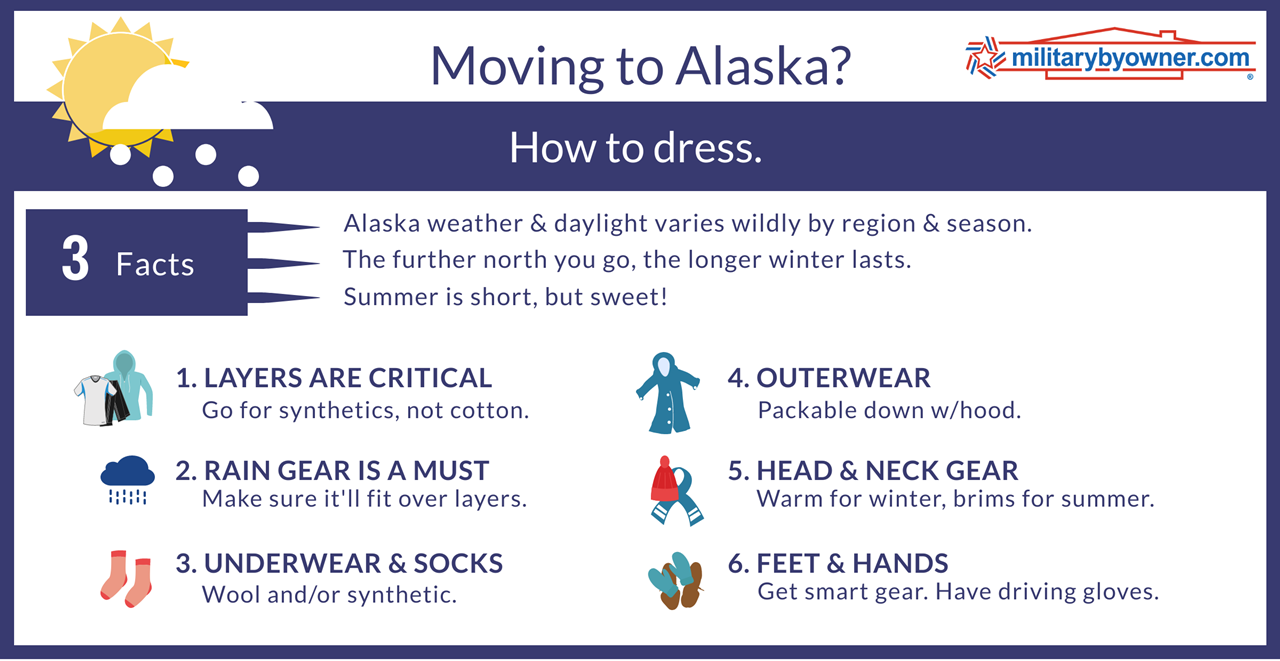
Black-Out Curtains
Bright summer sunshine during Alaskan summers can range from 19 to 21 hours a day during the peak of summer solstice, in mid-late June. Although many homes come with blinds (whether renting, buying, or on-base), blinds are not enough to fully darken a room. If you have heavy or full black-out curtains, bring them. Curtains can be difficult to repurpose between moves, due to varying window sizes and configurations, but chances are you’ll be able to repurpose and cover at least a few windows.
Shovels, Ice Scrapers, Snow Blowers, and Lawnmowers
If you have shovels and ice scrapers, certainly bring them, but you’ll find no shortage of them in Alaska. If you arrive in the August or early September timeframe, snow blowers should still be in stock at local stores. From mid-September on, snow blowers will be more difficult to acquire— both in ordering and shipping.
Anchorage and Fairbanks both have Home Depot and Lowe’s which offer ship-to-store options, but the item has to be in stock and available to ship. On-site, immediate inventory for snow blowers will be slim pickings, October on. The inverse is true for lawn mowers. In April and early May, lawn mowers are in stock. From June on, you’ll likely need to special order and wait for shipping. (Or hire an enterprising neighborhood teenager for the brief summer mowing season.)
Portable A/C Units and Fans
It may come as a surprise, but summer temps in Alaska can climb into the high 80s and 90s. During particularly warm periods, any available fans and A/C units get snapped up quickly from Alaskan store shelves.
Most Alaskan homes do not have air conditioning. Often, simply opening a few windows to let the breeze in can do the trick, but realize that Alaskan homes are built to retain heat, and most are very good at doing so. For some, a breeze will not be enough, and a portable A/C unit will be needed, especially for sleeping.
Unfortunately, Alaska is also subject to wildfires in summer months, meaning that, due to smoke, you may not be able to open your windows. In these scenarios, having a portable A/C unit will make an otherwise unbearably warm home manageable. It’s worth the small investment to bring a few fans and a portable A/C unit.
Workout Equipment
Buy workout equipment in the lower 48 before your move to Alaska. Equipment can be difficult to come by at any time of year, but dumbbell sets seem particularly difficult to find. Additionally, equipment is often heavy, which significantly increases shipping costs— even if you’re able to find a vendor that will ship to Alaska.
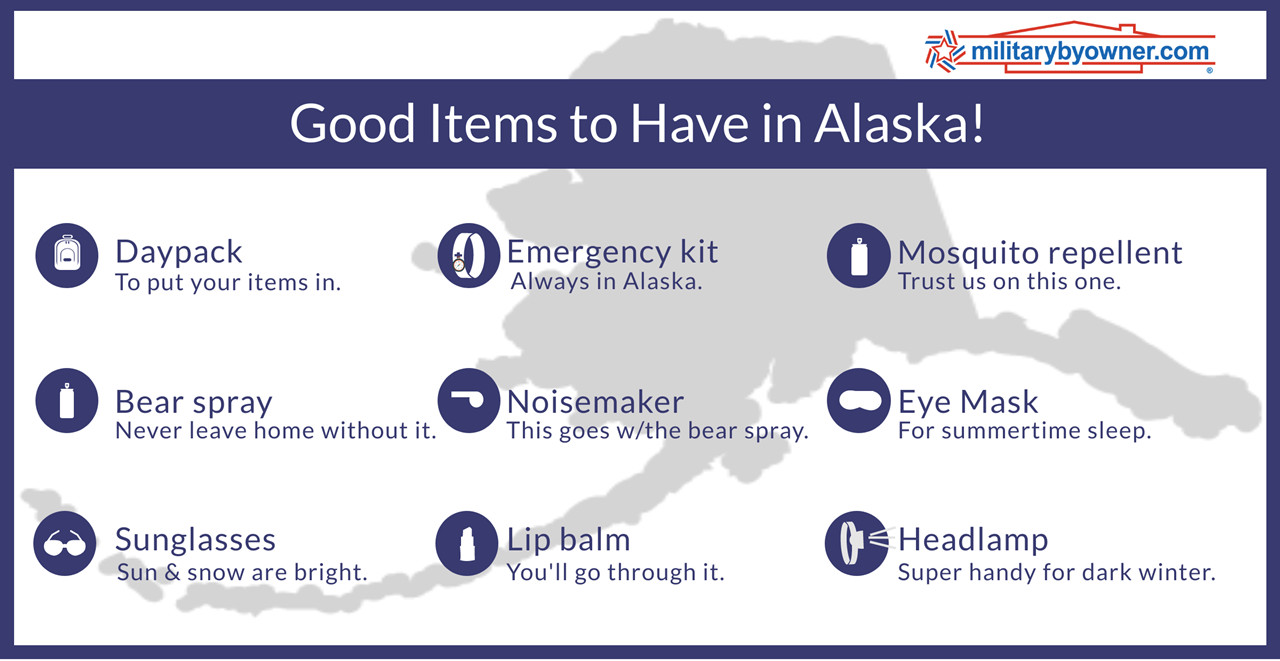
Should I worry about the cost of living in Alaska?
Alaska can be an expensive place to live. For instance, the cost of living in Fairbanks is 33% higher than the national average. However, military members stationed in Alaska will see an increased BAH. You’ll also get an overseas COLA (Cost of Living Allowance), which should compensate for the increased costs.
For military spouses and family members, most employers pay an increase due to the cost-of-living difference compared to the lower 48. The other upside is there are no state wage taxes. Depending on where you are coming from, this can be an immediate pay increase. Alaska also has no state sales tax.
Looking for a home in Alaska? Start your home search with MilitaryByOwner!
back to top
Getting Around and Driving in Alaska
It’s in your best interest to have a vehicle with AWD or FWD. The roads are maintained, but snow and ice are always the norm from October through April. There may be breaks in weather where the roads are clear, but it’s expected that vehicles will be studded, have snow tires, or chains through April 15.
Are engine block heaters necessary in Alaska?
In the Anchorage area, largely no. Adequately warming up the car and running the engine prior to travel is sufficient. For those headed further north to the Fairbanks area, Fort Wainwright, or Eielson AFB—yes, you’ll likely need an engine block heater.
Save money and get the block heater installed on your vehicle before you travel. Even if you’ll be traveling up to Alaska in summer months, installation and parts will be cheaper in the lower 48.
Do I need a home with a garage in Alaska?
Having a home with a garage is a welcomed convenience, but life in Alaska is certainly possible without one. While a garage is a nicety, not a necessity, what you will need to account and budget for is additional time to clear your vehicle of snow and ice on winter mornings and idle the engine before departing. In Fairbanks, it is more common to see parking lot outlets/towers to plug in engine heaters.
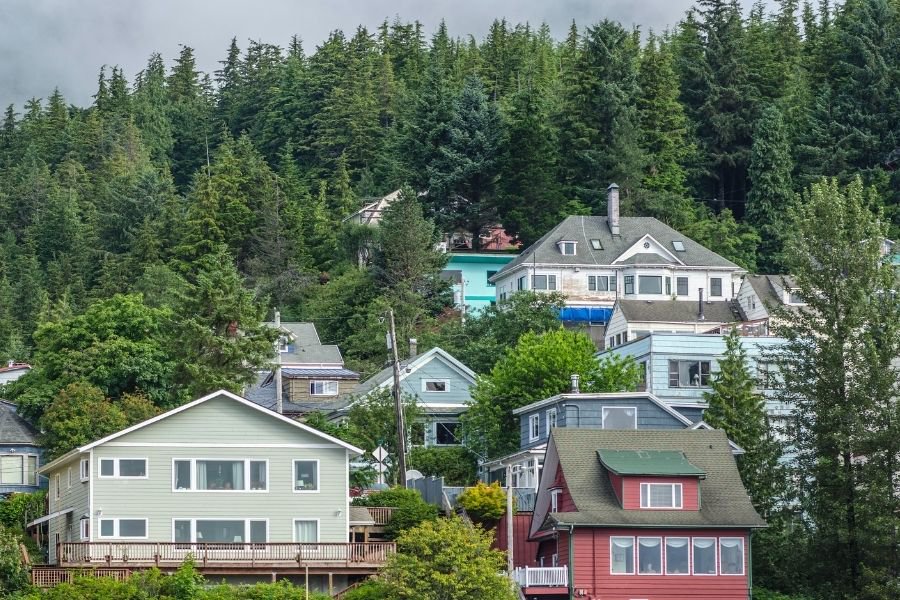
Homes in Ketchikan, Alaska. Image from Canva.
4WD, AWD, and 2-wheel Drive: Will my vehicle make it in Alaska?
You can bring a 2-wheel drive car to Alaska, and driving in summer months will not be an issue. In winter, you will be at a disadvantage in a 2WD. This can be somewhat mitigated by studded or winter tires or by adding extra weight in the trunk or truck bed, most often via sandbags.
4WD and all-wheel drives will absolutely make a difference in winter driving, giving you more traction on snowy, slick roads. Some cars offer 2WD and 4WD shifting options, and it is worth adding the option if you’re bringing the car to Alaska. Additionally, resale value in Alaska will be higher for a 4WD versus a 2WD.
How are the roads treated in Alaska?
By and large, Alaska treats their roads with sand and small gravel, not salt. Primary roads are treated first, and snow plows are dispatched early. Drivers will need to watch out for snow berms and ice humps, particularly toward shoulders and road midlines. With winter driving, black ice and dense fog (from nature and car exhaust) can also be an issue.
Tip: review your auto insurance for windshield replacement coverage and deductibles, and add coverage if you don’t have it. As roads are treated with small gravel, a busted windshield is an Alaskan rite of passage, particularly for highway driving.
What should I know about driving in winter in Alaska?
Budgeting for extra drive time is a must in winter. Keep the gas tank half-full at all times, winter especially. If you’re not comfortable or experienced in winter driving, practice driving in closed, empty parking lots. You’ll need to allow extra time for braking, and most Alaskans will keep a good distance between cars while driving for this reason.
In winter, keep a snow shovel and a bag of sand or kitty litter in the vehicle, along with a tow rope. In the event the vehicle becomes stuck, these items may make the difference in pulling the vehicle out or needing rescue.
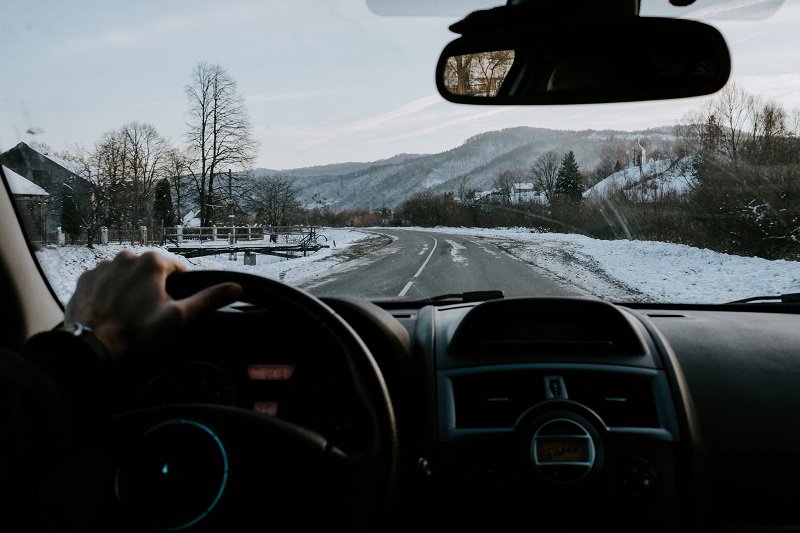
Photo by Taras Zaluzhnyi on Unsplash
Watch Out for Break-up Season and the Formation of Ice Roads
From late March to early May, Alaskan roads can become exceedingly treacherous due to the break-up season. As day temperatures rise above freezing, winter snow and ice slowly begins to melt. However, nighttime temps often dip back to below freezing, meaning all of the nice “melt” witnessed during the day, refreezes at night transforming roads into smooth sheets of crystal-clear ice.
Know Before You Go
Pay close attention to weather forecasts in Alaska. Before you travel, know the current driving conditions and road closures. Each military base will broadcast travel conditions (check with your installation to see if they use an app, email, website, etc.).
Check your local news for winter weather warnings and advisories, or you can dial 5-1-1 and request to be transferred to the NWS weather information line.
If you’re coming to Alaska via Canada, remember your passports! Even if you have a no-fee passport issued by the government, every member of the family will still need to have their regular passport.
Driving Long-Distance in Alaska
Whether winter, or summer, plan long-distance driving trips carefully. As you plan your route, ensure both roads and gas stations are open before you depart. Check the Alaska Department of Transportation and Public Facilities for live updates and road closures.
Carry survival kits containing sealed food and water, sleeping bags/blankets, extra winter clothing (hats/gloves/boots), additional gas/diesel, jumper cables, a tow rope, and at least one spare tire, toilet paper, hand sanitizer, and first-aid kits.
Drivers with pull-behind trailers have reported these trailers tend to be susceptible to flats, U-Haul trailers in particular. If you’re pulling a U-Haul, ensure you have their incident reporting contact info, any available spare tires, and instructions for getting help before you go.
If you will be driving The Alaska-Canada Highway, most commonly referred to as simply the “ALCAN,” ensure you check current Canadian border restrictions.
Cell coverage on the ALCAN (and remote Alaska in general) can be spotty, and there are dead zones. Many travelers carry a satellite phone in the event of emergencies and as a safety back-up plan. Garmin InReach products are frequently recommended by seasoned travelers. In fact, you may want to print out your map/driving directions, just in case. Additionally, if you’re traveling through Canada, let your bank know so they don’t freeze your funds, thus leaving you in a severe travel bind.
Further Reading Before Your Alaska Travel
The Milepost is an excellent travel guide that provides mile-by-mile information for the Alaskan highway system, with travel routes, maps, and more. The Facebook group, Driving the Alcan – Alaska Canadian Highway, is also a good peer-sharing platform of tips from fellow travelers, recommended hotels, and travel itineraries.
Getting to Remote Areas of Alaska
Due to the vast size of Alaska, airplane travel may be the quickest and, in some remote places, the only way to travel.
There's plane service between many of the larger cities via large carriers, along with regional carriers that provide sea planes for water landing or ski planes for landing in snow. See Travel Alaska for some options for air travel in the state.
Where does American Airlines travel?
American Airlines, along with with other airlines and private charters, connects many of the remote locations in Alaska.
back to top
Common Myths and Questions About Living in Alaska
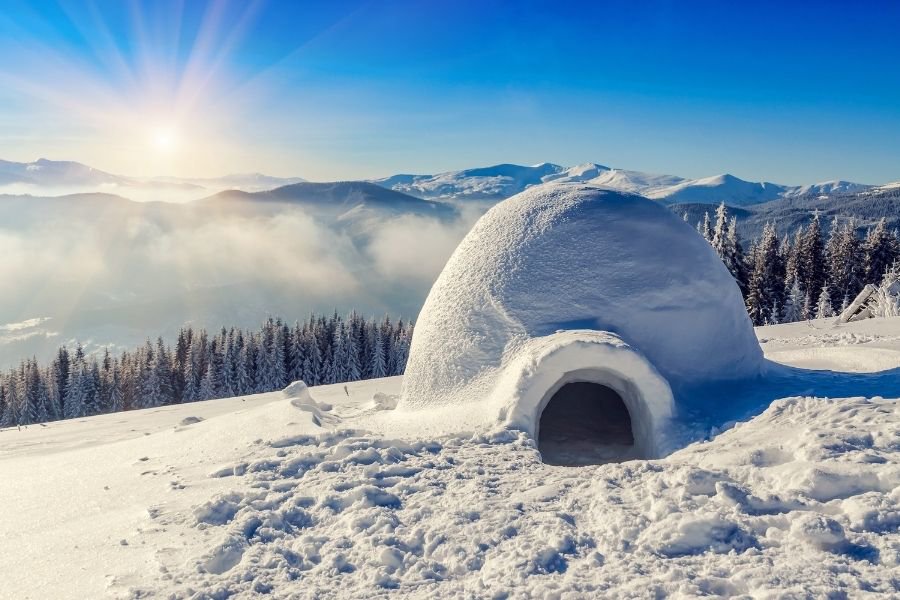
Image from Canva
Do some Alaskans still live in igloos?
Alaskans do not live in igloos; they are a way for emergency survival if stuck in a blizzard or some other unexpected event.
From Alaska.net:
Igloos were used by the Inuit people of Canada's Central Arctic and Greenland. If finding out how Alaska Natives lived for centuries is what you're interested in, Anchorage has cultural centers and museums with examples of traditional housing.
Is Alaska always dark in the winter? Does the sun really never set in the summer?
There are towns in Alaska that do live in complete darkness for months during long Arctic winters, but if you're stationed near Anchorage, know that Anchorage is not one of them. While the days will shorten during winter, Anchorage will still enjoy daylight for five to six hours, even in the winter.
On the plus side, by April the days stretch to twelve and thirteen hours of daylight. By July, it’s not uncommon to enjoy a sunset at 11 p.m. This can cause the summer months to feel hotter than they are, along with phenomenal plant growth. For example, a 2051-pound pumpkin holds the Alaska record.
Can you see penguins in Alaska?
Since penguins are only native to the Southern Hemisphere, the only penguins you’d see in Alaska would be in the zoo!
Can you see the northern lights in Alaska?
The best time to see the northern lights is between mid-September and late April. They're seen through the state, but are most visible in the Arctic and Interior regions.

Aurora Borealis (Northern Lights) Near the Arctic Circle in Alaska. Image from Canva.
What time is it in Alaska?
Almost all of Alaska observes Alaska Standard Time (AKST) with the corresponding Daylight Saving Time (DST) designation Alaska Daylight Time (AKDT). Alaska follows the same Daylight Saving Time (DST) schedule as the rest of the U.S.
Parts of the Aleutian Islands use Hawaii-Aleutian Standard Time (HAST) and Hawaii-Aleutian Daylight Time (HADT) during DST. (Source: timeanddate.com)
So, for the majority of Alaska, they’re one hour behind the Pacific Time Zone.
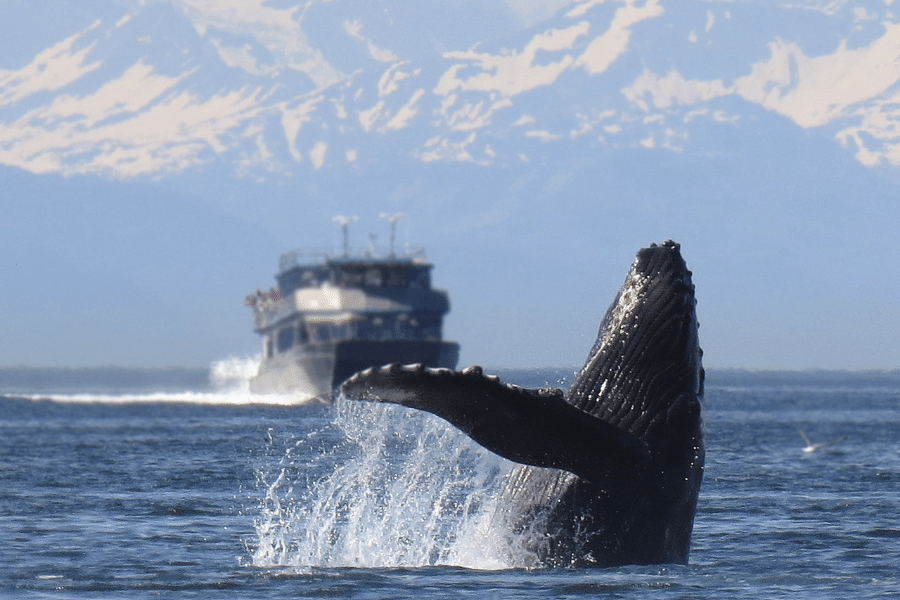
Image from Canva
Why do people love living in Alaska?
People mention the unparalleled natural beauty, year-round outdoor activities, and the abundant opportunities for hunting, fishing, and camping as reasons they love Alaska.
Many military members choose Alaska for their retirement, especially in the Anchorage area near JBER. In addition to a tax-friendly environment (there is no state income tax in Alaska), JBER often parlays into a satisfying post-military career as a federal civilian. Additionally, the Anchorage area is very military friendly, and offers excellent veteran medical care through the VA Hospital, which also shares state-of-the-art medical facilities with the JBER medical group.
The convenience and amenities of a large city, combined with the retiree benefits of continued military installation access, make JBER an attractive retirement destination. The jaw-dropping beauty of the surrounding mountains, endless hiking trails, rivers and lakes, glaciers, and wildlife are truly a nature-lover’s dream come true.
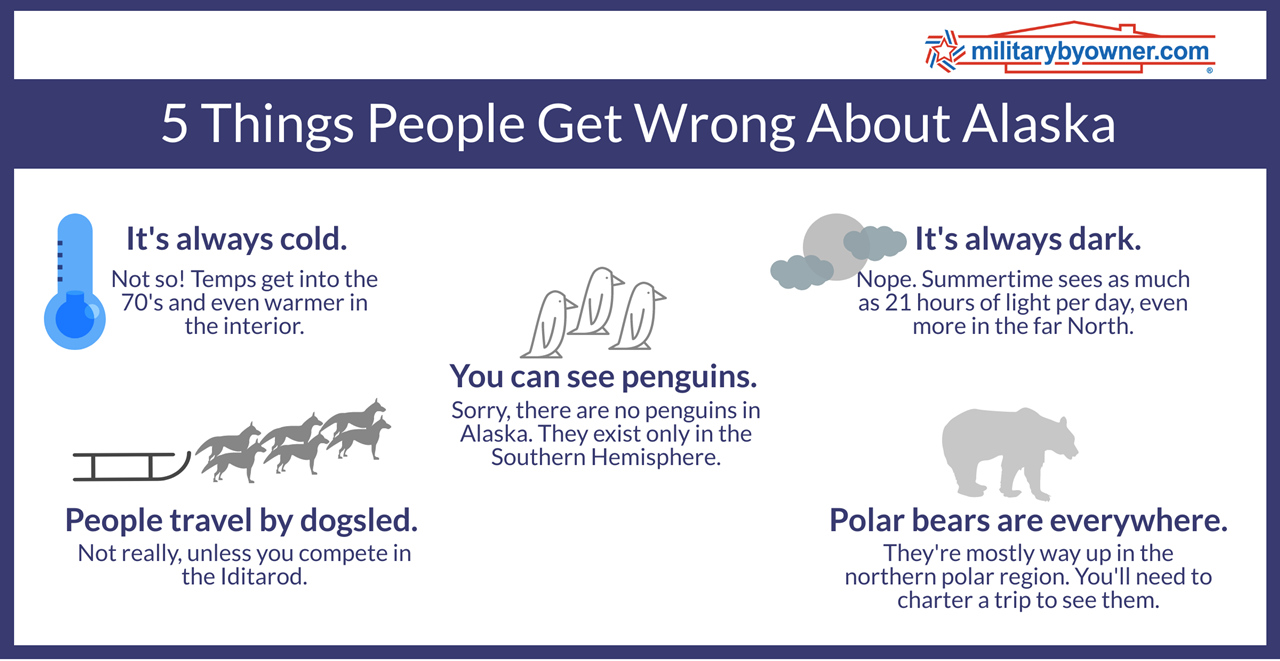
What safety concerns should I consider when moving to Alaska?
Staying Safe and Healthy: General Winter Weather Tips and Expectations
In winter, dress warmly and in layers, with adequate boots (or have a pair in the car), hats/gloves, and a survival kit, no matter how far you’re traveling. An accident on a well-traveled highway can quickly back up traffic in winter, leaving motorists stranded in freezing temps for hours while crews work.
Roads are subject to “frost-heaves” and can cause motorists to lose control, particularly if pulling a trailer. (Frost heaving is when ice freezes under pavement structures, then rises, forming humps and buckling in roadways.) Driving at high speeds over frost heaves can easily launch your car airborne, or jack-knife a trailer.
Drive carefully, and slow down in adverse conditions. Always let someone know your travel route, expected duration of travel, and your plans for checking back in. Budget funds to buy a snow blower; it’s a worthwhile purchase. Machine-assisted clearing of snow significantly reduces shoveling times, and thus exposure to winter temps.

Anchorage, Alaska skyline. Image from Canva.
Vitamin D and “Happy Lights” in Winter
Unless you’ll be traveling further north to the Barrow area, both Fairbanks and Anchorage do have some sunlight in winter, although it tends to be weaker and averages 4-5 hours a day. Some people are susceptible to Seasonal Affective Disorder (SAD) and benefit greatly from additional Vitamin D supplements, in addition to broad-spectrum light therapy via “happy lights” and/or sunlamps. If you notice you’re feeling the winter blues, reach out to your healthcare provider to form a treatment plan.
Earthquakes in Alaska
Alaska averages 45 magnitude 5.0-6.0 earthquakes per year, with one 7.0-8.0 per year. A 6.0 is enough to knock furniture over and pictures off the walls. A general rule of thumb is, if you are inside, stay inside and take cover. If you’re outside, get away from buildings or anything that could fall on you.
The State of Alaska’s Seismic Hazards Safety Commission provides in-depth, detailed earthquake information.
Tip: If you’re buying a home in Alaska, consider adding an earthquake insurance policy to your liability coverage as damage from earthquakes is excluded in most standard liability policies.
Was there an earthquake in Alaska today?
Alaska has more earthquakes than any other region of the United States, which means earthquakes will occur that you never feel! You can see the latest earthquakes in Alaska at the Alaska Earthquake Center.
back to top
Alaska Wildlife

Image from Canva
Driving in Moose Country
Moose-vehicle collisions pose a significant threat to motorists throughout Alaska, with roughly 800 collisions annually. There tend to be more moose on highways during winter months, as vegetation becomes sparse and moose are looking for food, as moose do not hibernate.
Watch for moose crossing signs and scan the sides of the road for wildlife. If you see a moose, slow down, stop if necessary, and turn on your hazard lights to warn other drivers.
Tip: When you see a cow (non-antlered) moose near the road, slow down and be prepared to stop. She likely has a calf or two trailing her.
Moose Safety
You will see moose in Alaska, even in your yard. Though you may think they’re friendly, they can be dangerous. They look slow and gentle, but their sheer size means they can reach you very quickly. A sow with a calf can be one of the most dangerous things in Alaska, as they’re very protective and unpredictable. Loose, aggressive dogs can be hurt or killed by moose.
However, moose largely tend to avoid or ignore people. If a moose charges you, then run, ideally to shelter. Try to get something large between you and the moose, such as a car, tree, or trash can.
Bear Safety
Bears are everywhere, so make noise while walking and hiking so you don’t surprise a bear. Surprised bears may react out of fear and charge. Never approach bears; give them space, particularly females with cubs. Bring a bear deterrent, either bear spray, an air horn, or both. If a bear sees or hears you coming, the bear will almost always move away from you.
If you see a bear that does not notice you, stay calm and quietly leave the area from the same direction you arrived. Ready your deterrent and back away, keeping your eyes on the bear. If a bear does notice you, then stay calm and talk to the bear calmly (this helps identify you as human), ready your deterrent, and make an effort to look bigger by slowly raising your arms over your head.
Bear responses do vary in regard to an offensive versus defensive attack. The Alaska Department of Fish and Game has further information on bear behavior and safety.
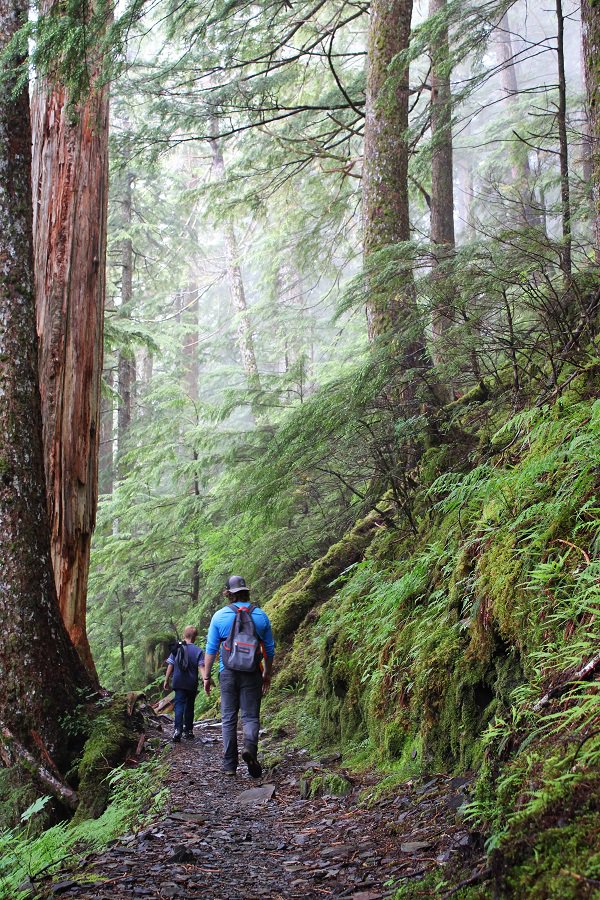
Hiking on Deer Mountain Trail, Ketchikan, Alaska. Photo by Chris Riggs on Unsplash.
Preparing for Wildlife Encounters on Foot
Wildlife encounters can happen while hiking, walking, camping, or fishing. If you’ll be outdoors, take precautions to stay safe. Remember that you’re more likely to encounter a moose than a bear. Usually, a moose will simply keep walking past, provided you do not attempt to get closer. Moose or bear: if the animal perceives you as a threat, they will charge. Never approach wildlife; give them space. According to the Alaska Air Force Deptartment of Fish and Game, more people are injured by moose than bears.
Are there wolves in Alaska?
There are wolves in Alaska, but they tend to be pretty elusive. They aren’t normally a big concern near populated areas, but if conditions are right and food is scarce, they can be an issue.
Your base will likely have a mandatory in-brief regarding wildlife.
back to top
Moving to Alaska with Pets
What should I know about moving to Alaska with pets?
If you’re traveling with pets, they will either fly with you in-cabin, fly as air cargo (either due to size or in-cabin non-availability), or accompany you as you drive.
According to the Alaskan State Veterinarian:
“All animals are required to have a current Certificate of Veterinary Inspection (CVI) or Health Certificate to enter the state of Alaska.”

Image from Canva
10-Day Health Certificate, Proof of Vaccinations, Microchip
For some air travel, a 10-day health certificate will be mandatory to board the pet, particularly if the pet is flying as cargo. The general sequence to obtain a health certificate is: microchip implantation, rabies (and dog/cat specific) vaccinations, then a health certificate may be issued. Health certificates must be issued by a USDA certified veterinarian. Most military installation veterinarians are USDA certified, and can generate a 10-day health certificate.
Note: You’ll need to determine your date of travel and ensure the 10-day window covers your transit time and will not expire en route. Most travelers aim for pet certificates two to three days before travel to accommodate any unexpected travel delays.
Commercial Air and Space-A Travel with Pets
According to Alaska Air,
“All pets traveling in the cargo compartment on Alaska Airlines (including flights operated by Horizon, SkyWest and PenAir) will be required to have a health certificate dated within 10 days of outbound travel... A health certificate will not be required for pets traveling in the cabin with their passenger.”
Tip: Expend the effort to get a 10-day health certificate, giving yourself peace of mind and maximum flexibility. If your pet will be traveling in the cabin, remember that pets need tickets, too. Don’t assume you’ll simply bring a pet onboard as an in-cabin guest. Call the airline and ensure this is denoted on your ticket, or you and your pet may be denied.
Depending on scheduling, it may be possible to fly to Alaska with your pet aboard military Space-A travel. Generally speaking, in-cabin spots for pets are limited and book quickly. Find full details for pet travel on the Air Mobility Command (AMC) site.
Breed Restrictions for Air Travel to Alaska
Brachycephalic or short-nosed breeds are at a higher risk of overheating or suffering respiratory distress due to constricted airways. The following Brachycephalic breeds and breed mixtures are prohibited from flying in the cargo compartment on Alaska Airlines:
Dogs: American Pit Bull, American Staffordshire Terrier, Boston Terrier, Boxer, Brussels Griffon, Mastiff (All Breeds), Bulldog, Bull Terrier, Chow Chow, Dutch Pug, English Bulldog, English Toy Spaniel, French Bulldog, Japanese Boxer, Japanese Pug, Japanese Spaniel, Pekingese, Pug, Shih Tzu, Staffordshire Bull Terrier.
Cats: Burmese, Exotic Shorthair, Himalayan, Persian.
Canada Border Services Agency
If you’re driving to Alaska, you’ll need to transit through Canada. Check the latest Canadian border requirements here.
Book Pet-Friendly Lodging Early
Whether you’re driving or flying to Alaska, book pet-friendly lodging early. There are some pet-friendly rooms on military installations, but these are limited. If your installation doesn’t have a pet-friendly room available, ensure you get a “non-availability letter” issued from lodging, then book your own accommodations on the local economy for a pet-friendly hotel.
back to top
Preparing for a Move to Alaska with Kids
What should I know about moving to Alaska with kids?
Military families with children will be happy to learn that there are many activities available! Alaska is a winter and summer playground that caters to all ages. In fact, many public schools have outdoor ice rinks that can be used as soon as they’re cleared.
On your military installation, you’re bound to find many intramural competitive sports. There are local clubs for ice hockey, competitive skiing (downhill and cross country), baseball, soccer, football, dance, volleyball, and more. Many of the same sports in the lower 48 are found in Alaska. Several military spouses advise that getting your kids into sports and clubs over the winter can help alleviate the dreaded “cabin fever” that can set in.

Registering for School in Alaska
In order to register for Alaskan public schools, you’ll need students’ shot records, birth certificate, proof of residence (a bill showing your new address should suffice), and prior school records. The military are allowed an additional amount of time to obtain shot records, and children are admitted without them. You can find school rankings for both private and public Alaska schools on Niche.
Private Schools and Homeschooling in Alaska
You can find rankings for private schools in Alaska on Private School Review. Homeschoolers should follow the guidelines provided by the Alaska Department of Education.
Alaska School Liaison Office Information
Eielson AFB: Child and Youth Services Air Force School Liaison Program
Location:
School Age Center
777 Kodiak St.
Eielson Air Force Base, AK 99702
Contact:
DSN: 317-317-2178
Cell: 907-385-9460
Fort Greely: Fort Greely School Support Services
Building 661
Arctic Ave
Fort Greely, AK 99731
Contact: 907-873-4600
DSN: 317-873-4600
Fort Wainwright: Fort Wainwright School Support Services
Location:
Neely Road, BLDG 4109
Fort Wainwright, Alaska 99703
Contact: (907) 361-9897
Joint Base Elmendorf-Richardson: School Liaison Services
Location:
Richardson Drive
Building #600
JBER, Alaska 99505
Contact: 907-384-7500
907-384-1505
Alaska Coast Guard: USCG School Liaison
back to top
Military Spouse Connections and Employment in Alaska

Photo by Priscilla Du Preez on Unsplash
Alaska Employment Outlook
Alaska has a slightly higher unemployment rate than the rest of the country. According to Alaska.gov:
“Alaska ranks 20th among the states in per capita income. Cost of living comparisons are imprecise, but one study ranks Kodiak, Juneau, Fairbanks and Anchorage among the survey's 10 most expensive cities to live in. Unemployment in Alaska is above the national average. The employment growth rate is slow, below one percent. All in all, recent economic growth has been slow.”
Military Spouse Licensing in Alaska
Good news for military spouses looking to transfer professional licensure! The state of Alaska is doing its best to make the transition easier.
From Alaska.gov:
“Active duty military personnel with Alaska orders and spouses of active duty military personnel with Alaska orders may request temporary licensure in accordance with AS 08.01.063 - AS 08.01.064. Temporary licenses are available for most license types listed below and are valid for 180 days.
Barring any circumstances outside our control, temporary license applications will be issued within 30 days of receipt of a complete qualifying application.”
Make Military Spouse Connections in Alaska
View the US Army Alaska's Thriving in Alaska Series Ep. 1: Spouse Advice
(Spouse Advice is a video featuring spouses from Joint Base Elmendorf-Richardson and Fort Wainwright discussing one thing they'd tell a friend coming to Alaska-- that you wouldn't know unless you've lived there!)
back to top
Your Alaska Bucket List & Things to Do
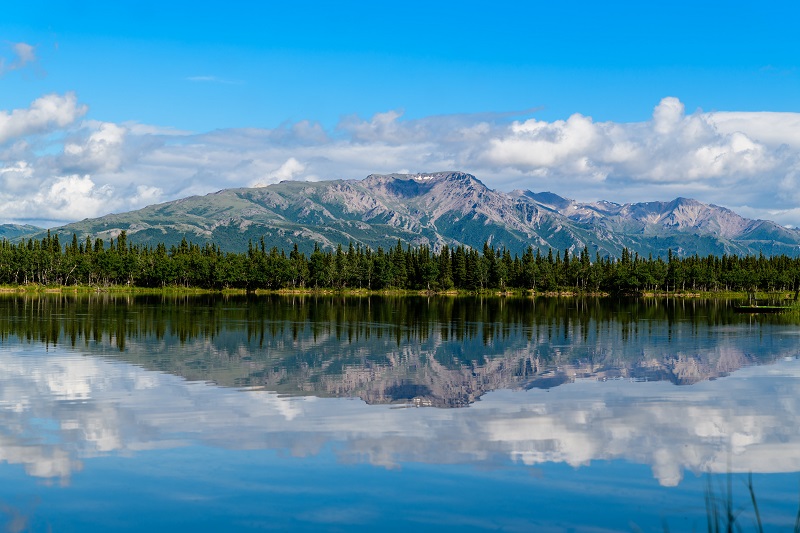
Denali National Park and Preserve - Photo by Hari Nandakumar on Unsplash
Military families can thrive in Alaska! With the incredible outdoor landscape and amenities designed to make life even more fun, you’ll find so much to do here. Not only can you expect to spend days kayaking, fishing, hiking, camping, gazing at the Northern Lights, rafting the rapids, and more while you explore the great outdoors, but you’ll find lots to do on or near your military base. Start with this list!
Seward Highway drive: This drive hugs the Cook Inlet and the Chugach Mountain range. It boasts two daily bore tides which bring surfers from all over the world to ride the massive wave into the inlet. It's not uncommon to see Beluga whales in the later summer months in the Inlet on this drive.
Wildlife Conservation Center: This is a drive-through center of rescued wildlife and is a safe way to view bears up close.
Arctic Valley: In the summer months this hiking/skiing area located just off Fort Richardson has many trails and views. In later summer months, blueberries are ripe and prime for picking.
Girdwood: Home to Alyeska ski resort, many trails, and eclectic restaurants. Home of the annual Forest Festival and Blueberry Festival.
Statewide camping and fishing: Alaska boasts many camping and fishing areas. With over 3 million lakes, you’ll never visit them all!
Denali National Park: Home to America’s tallest peak, the view as you drive into Denali National Park is awe inspiring. Bus passes can be purchased online, and it is an all-day experience. The drive is not for those who cannot handle tight turns. You must pack in your own food and drink and return with your trash.

Alaskan Railroad. Image from Canva.
Things to Do Near Anchorage (JBER, Coast Guard Sector Anchorage)
This area is an outdoors paradise. With a major international airport, mountain ranges, forests and hiking, and access to the sea, there are plenty of both solo and family-friendly things to do.
Here's a few ideas!
- Nature cruises to the Kenai Fjords in Seward.
- Alaskan Railroad: Explore the Alaskan coast and wilderness.
- Iditarod Headquarters: Learn about Alaskan history.
- Fishing: Winter and summer. Watch the salmon run (May-Sept).
- Brooks Falls, Katmai National Park: Bears love salmon too, and you can watch them in action.
- Hiking: Lace up those hiking boots, and explore hundreds of trails around Anchorage.
- Hillberg ski area: In winter, hit the slopes next to JBER.
- Elmendorf Aero Club: Get your pilot’s license right on JBER. One out of every 50 Alaskans has a pilot license!
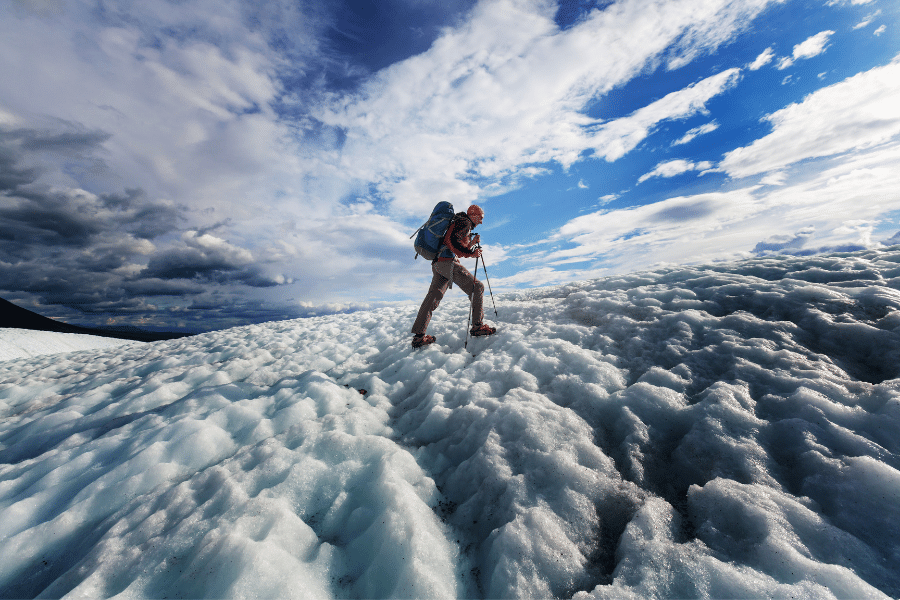
Hike in Wrangell-St. Elias National Park, Alaska. Image from Canva.
Things to Do Near Fairbanks (Fort Wainwright, Eielson AFB)
Fairbanks is the largest city in the Interior region of Alaska. You’ll find pristine rivers, beautiful mountain ranges, and plenty of opportunity to get outdoors. The famous Iditarod runs right by Fort Wainwright!
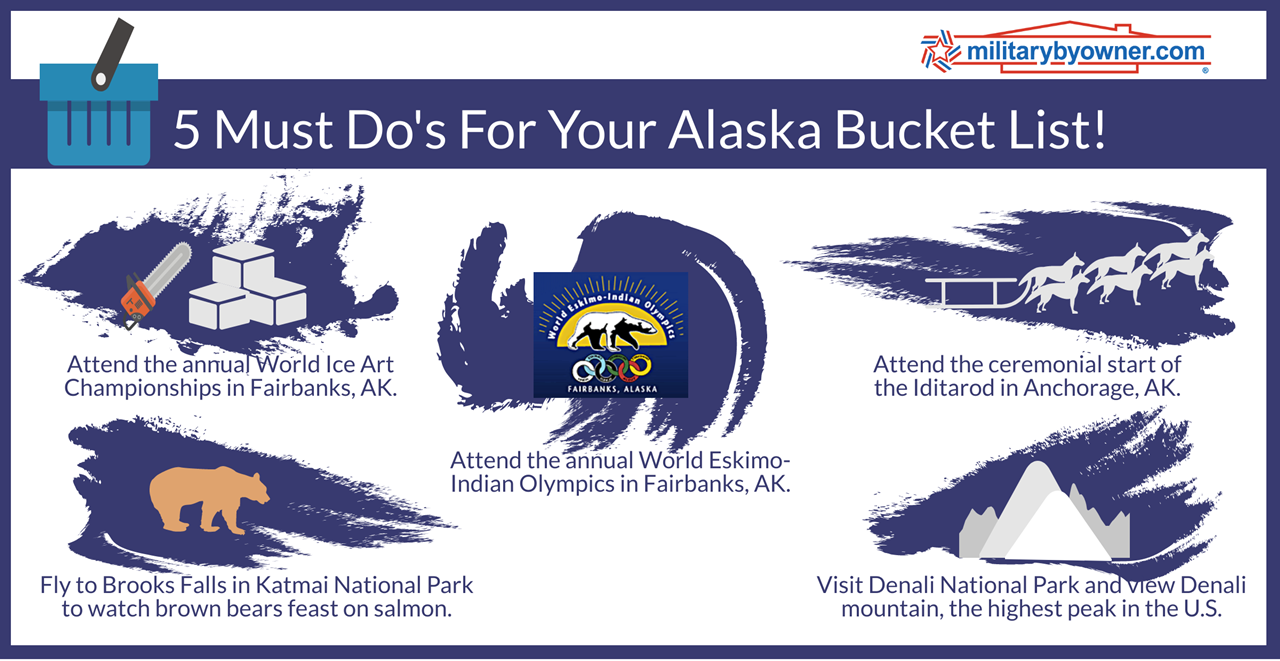
Learn more about your Alaska duty station!
Alaska base information pages:
By Jen McDonald and Kristi Adams, with input from Christy Shields
Do you have an upcoming PCS move? Start planning with our free library of resources for your military move!

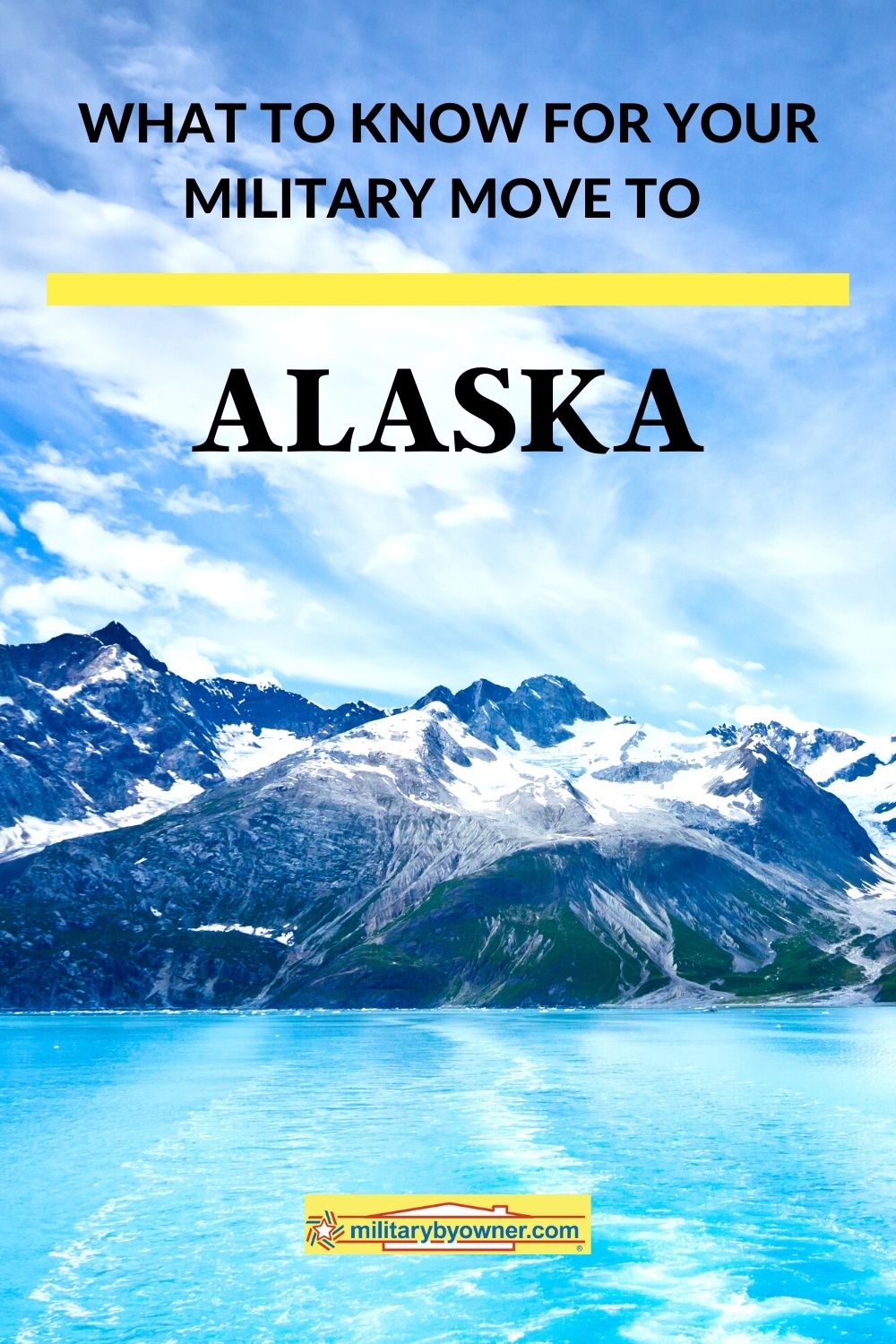
back to top